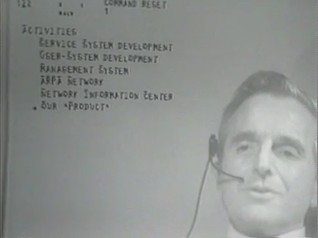And here's what Enterprise 2.0 looked like in 1968 | Dealing lightning with both hands...
The video This is what the web looked like in 1994 - a DEC promotional video of that era - got a bit of attention recently. Just for the record - here's what Enterprise 2.0 looked like in 1968 - courtesy Doug Engelbart and his team at SRI:
Doug bootstrapped Augment to design, build and extend itself, showing how Enterprise 2.0 will work when we finally gets our acts together. Augment was used as a collaborative platform for: CAD/CAE design of its own hardware components; sofware development; a software repository; issue tracking; a research notebook and public journal for ARPANET software development - running as ARPANet node number three.
See Doug Engelbart's December 1968 demonstration.
"Doug Engelbart sat under a twenty-two-foot-high video screen, "dealing lightning with both hands." At least that's the way it seemed to Chuck Thacker, a young Xerox PARC computer designer who was later shown a video of the demonstration that changed the course of the computer world.
"On December 9, 1968, the oNLine System was shown publicly to the world for the first time. Encouraged by [Bob] Taylor, Engelbart had chosen the annual Fall Joint Computer Conference, the computer industry's premier gathering, for Augment's debut. In the darkened Brooks Hall auditorium in San Francisco, all the seats were filled and people lined the walls. On the giant video screen at his back, Engelbart demonstrated a system that seemed like science fiction to a data-processing world reared on punched cards and typewriter terminals. In one stunning ninety-minute session, he showed how it was possible to edit text on a display screen to make hypertext links from one electronic document to another, and to mix text and graphics, and even video and graphics. He also sketched out a vision of an experimental computer network to be called ARPAnet and suggested that within a year he would be able to give the same demonstration remotely to locations across the country. In short, every significant aspect of today's computing world was revealed in a magnificent hour and a half.
"There were two things that particularly dazzled the audience on that rainy Monday morning in December 1968: First, computing had made the leap from number crunching to become a communications and information-retrieval tool. Second, the machine was being used interactively with all its resources appearing to be devoted to a single individual! It was the first time that truly personal computing had been seen.
"Engelbart spoke softly in a monotone, his voice given a slightly eerie quality by the reverberations of the cavernous hall. Wearing a short-sleeved white shirt and a tie and seated at a desk on a custom-designed Herman Miller chair, he introduced the world to cyberspace. He showed the nation's best computer scientists and hardware engineers how people would in the future work together and share complex digital information instantaneously, even though they might be a world apart.
"For many who witnessed it, it was more than a bolt from the blue: It was a religious experience, inspiring the same kinds of passion that Vannevar Bush's Memex article had given rise to for Engelbart twenty-three years earlier. Computing was just beginning to have an impact on society. Local newspaper articles that preceded the conference noted that there would be discussions of the privacy implications of the use of computers, and a public forum, "Information, Computers and the Political Process," would feature broadcaster Edward P. Morgan and Santa Clara County's member of the House of Representatives, Paul McCloskey Jr.
"But Engelbart stole the show. In the days afterward, the published accounts of the event described nothing else. Years later, his talk remained 'the mother of all demos,' in the words of Andries van Dam, a Brown University computer scientist. In many ways, it is still the most remarkable computer-technology demonstration of all time."
Quoted from John Markoff's What the Dormouse Said by Metroactive.com review, From Pranksters to PCs.
Doug is proverbially described as being twenty to thirty years ahead of his time - in this case it may be forty years - but I think he'll do it again. In the words of Alan Kay: "I don't known what Silicon Valley will do when it runs out of Doug's ideas".
Update Remembering Doug Engelbart, 30 January 1925 - 2 July 2013
See also Doug Engelbart | 85th Birthday Jan 30, 2010
Tricycles vs. Training Wheels
Tuesday Dec 9, 2008 | Forty years after the Mother of All Demos
Traction Roots - Doug Engelbart
As We May Work - Andy van Dam

 I18N ERROR: @tsiskin#footer_RSS_Feed
I18N ERROR: @tsiskin#footer_RSS_Feed